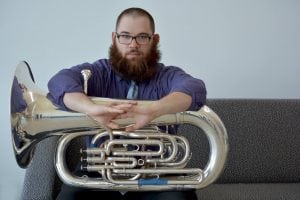By Aaron Hynds, Special to the Sybaritic Singer
I am fortunate enough to have attended the SPLICE Institute for the last three summers, and each year has been better than the last. The Institute is now in its fifth year, and it forms the center of a rapidly-expanding SPLICE community within the larger electroacoustic scene. The core faculty of the Institute is made up of the SPLICE Ensemble (composer-performers Keith Kirchoff, Sam Wells, and Adam Vidiksis), and composers Elainie Lillios, Christopher Biggs, and Per Bloland. Each Institute has two featured guests, one performer and one composer. In my three years, those guests have been Élise Roy (flutist/composer), Mari Kimura (violinist/composer), Dana Jessen (bassoonist/composer/improviser), Joo Won Park (composer/improviser), Paula Matthesen (composer/improviser), and Sam Pluta (composer/improviser). The talent and upmost musicality evinced by the faculty is truly one of the highlights of the Institute, among many others.

Packed into the week-long event is a wide variety of instructional classes, presentations, and concerts (one every night). One of the greatest aspects of the SPLICE Institute is its focus on people at all levels of ability—whether you are a complete beginner in the field of electroacoustic (EA) music, or an experienced practitioner, there is a place for you at the Institute. The courses are split into different tracks, generally following a Beginner-Intermediate-Advanced format. As is true with the practice of the majority of the electroacoustic community, the composition-centric classes at SPLICE often focus on some elements of the Max/MSP visual programming language. Performers and composers can elect to take classes on other elements of the EA performance process, including very helpful classes on the fundamentals of live audio and strategies for performing with electronics. In the last few years, the curriculum for SPLICE has opened up immensely: the SuperCollider language is becoming more and more important every year (author’s note: Yay, go SC!!!), and Ableton Live/Max for Live has definitely taken hold as a core component of the tech classes on offer. Participants are allowed to pick and choose their own schedule from the classes on offer, which is one of the key ways in which the SPLICE Institute is tailored to the needs of the participants. To reiterate, there are classes of interest for anyone interested in electroacoustic music, from the newest of beginners all the way up to the most seasoned of professionals. That such a spread of classes is offered within the space of just one week is, frankly, a miracle of scheduling!
Attendees can choose to either audit the week’s events or enroll as participants, with the second group being paired up into composer-performer duos. The composers write a new work for the Institute, and workshop the new composition with their collaborative performer during the week of the Institute. Each pair is assigned a faculty mentor, and there are plenty of additional opportunities to get feedback on the works throughout the week. The final day of the Institute is an incredible marathon of world premieres, as the composer-performer groups perform the works that they have workshopped all week. It is truly incredible to see the myriad different approaches to electroacoustic music on display during the final day of the Institute, and this marathon of concerts is a fitting cap to the week of events.
I have attended the Institute as both a performer and composer, and both tracks have provided me with a ton of great new information, approaches to my craft, and plenty of supportive, helpful feedback. I leave Kalamazoo each summer with a year’s worth of inspiration, and the community that is formed during the Institute continues on past the end of the week. I have formed some of my most fruitful and lasting collaborations through the SPLICE Institute, and it is perhaps this element that makes me most excited for the start of the Institute each summer. The faculty are also incredible to work with, and you’d be hard pressed to find a more supportive group of musicians.
The SPLICE Institute seems to grow exponentially each year, yet it still manages to be an inclusive environment for novice and professional alike. This is a truly great achievement, and in my experience, that is a rare quality within the world of summer music festivals. If you have even a passing interest in electroacoustic music, you owe it to yourself to attend the SPLICE Institute. You’ll leave with a renewed passion for your craft, a ton of inspiration and drive for your musical projects, and many new and lasting friendships. Here’s to many more years of the SPLICE Institute!
 Aaron Hynds is a Nebraska-based tubist, composer, and audio engineer. His work centers on the combination of electronics, improvisation, and live performance, with recent works including Robot; ready for piano+computer and Sin-eater for tuba+computer. He is the Sound Production Coordinator for the Department of Music, Theatre, and Dance at the University of Nebraska at Kearney, and is also a doctoral candidate in Contemporary Music from Bowling Green State University.
Aaron Hynds is a Nebraska-based tubist, composer, and audio engineer. His work centers on the combination of electronics, improvisation, and live performance, with recent works including Robot; ready for piano+computer and Sin-eater for tuba+computer. He is the Sound Production Coordinator for the Department of Music, Theatre, and Dance at the University of Nebraska at Kearney, and is also a doctoral candidate in Contemporary Music from Bowling Green State University.
